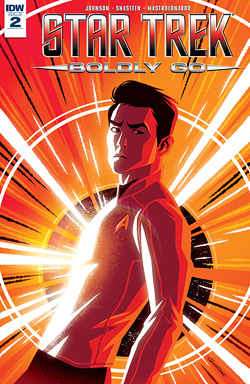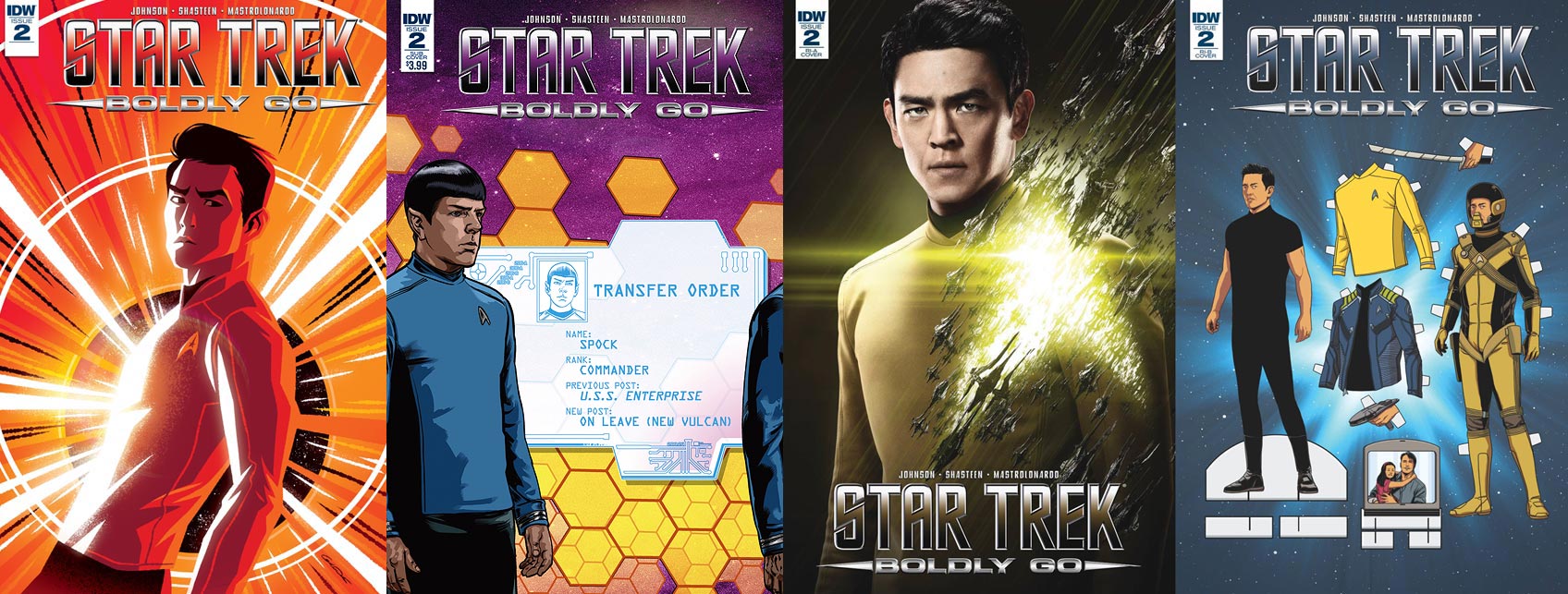Blind devotion is the harbinger of a closed mind, and to be honest, I find myself guilty of manifesting this trait way too often in my pursuit of Star Trek fandom, particularly when it comes to the schism between new and old Trek.
But Tony Shasteen and Mike Johnson have given us something to think about in their second issue of IDW Publishing’s Star Trek: Boldly Go. Well, me, at least.
When I was growing up, the works of James Blish, Sondra Marshak, or Diane Carey, to name a few, expanded the universe of Trek to include wonderful diversity of different characters and perspectives of looking at this franchise. In fact, there are still parts of the classic Trek novel “The Price of the Phoenix” that still disturb me to this day, but I have learned to live with it.
Even if some of us didn’t agree or like changes, we still accepted them as a part of Trek and I think a number of fans, myself included, have forgotten that aspect of enjoying a fandom. We all accepted and forgave the male mini-skirt, right?

The Kelvin Timeline is now an inextricable part of Trek and it’s the work of creators like Johnson and Shasteen that have allowed us to remember how to enjoy a fandom. Star Trek: Boldly Go expands the scope of the cinematic version of Star Trek by indulging in that freedom that comic storytelling permits.
We get to see characters’ personalities developing in different directions, read new and unexpected dialogue or even have the chance to look at the franchise from various characters’ points of view.
Johnson’s story structure for this book allows for this exploration. The comic is the ideal medium for characters to be in different parts of the galaxy while still contributing to a central storyline. We gain more insight into Uhura’s relationship with Spock while being able to play a supportive role to Kirk and McCoy on board the USS Endeavour, patiently waiting for the construction of the new Enterprise.
Even Sulu has a new role on board the USS Concord as First Officer to a familiar face for canon fans, Captain Terrell.

It’s the re-direction of the Kelvin Timeline background with considerations like the inclusion of Captain Terrell that makes this story novel and workable for canon fans. Of course, the arrival of the Borg during Captain Kirk’s timeline is a bit of an early liberty, but why not?
The new timeline is anyone’s game at this point and there is no doubt that the Borg are a harsh foe and probably the greatest threat to the Federation ever encountered. After all, there was a hint of them in a Star Trek: Enterprise episode so there is no denying their appeal.
However their presence does mean a great threat and personal cost to the crews of the Endeavour and the Concord. Poor Captain Terrell; he doesn’t seem to fare well in either timeline.
The variant covers of this book make it a great collectible. There seems to be a focus on Hikaru Sulu this issue as he features prominently on three of the four variants.
- The regular cover by George Caltsoudas is a typical cover format; we see a centrally featured character superimposed over a stylistic background. The explosive pattern is dynamic and suggests a resolute determination to Sulu and an importance that normally wouldn’t be associated with a supportive character. Of course, with the unfolding of events in this story, it is appropriate and matches the mood of this particular book.
- The subscription cover by Tony Shasteen is certainly my favourite. Of course, this is an excerpt form a larger montage of the characters with their duty orders in the background. This one is of Commander Spock and Shasteen does a wonderful job of representing the likeness of Zachary Quinto in the foreground.
- The third is a retailer incentive cover and features a photographed lay-out of John Cho and a background featuring the swarm vessels from Star Trek Beyond. Probably my least-liked, but again it is an appropriate one given the nature of the significance Sulu plays in this story.
- Finally, the fourth cover is another paper doll by Marc Laming of, once more, Hikaru Sulu. This doll includes alternative clothing and accouterments like the regular duty uniform blouse, the encounter jacket, the pressure suit, a hand phaser, the sectional katana blade we saw in the 2009 Star Trek film and even a photograph of Sulu’s husband and child. This final addition to the doll’s components is a particular poignant one and actually serves as a thought counterpoint to the usual whimsical nature of this type of doll.

Whatever the form that Trek takes, it’s the duty of fans to assimilate those changes and learn to either appreciate them for their worth, or simply just accept them. When all is said and done, whatever sense of ownership Trek fans feel for their fandom, it isn’t theirs. If they want to have some sort of say in the story, then work within the established system and create something that can be added to the tapestry as other creators have done.
I’ve said this elsewhere before, but these stories have a life of their own; they grow and develop as organically as we do. But for us, with growth comes age, and with age comes the reluctance to accept change. Our mindsets find rigidity and we tend to stay with what we like.
Trek fans are not immune to this process but if a publisher like IDW that has repeatedly demonstrated its respect for the franchise time and time again can work to expand the universe of the Kelvin Timeline, then as fans, it is our duty to accept these changes and enjoy them for what they represent. If it isn’t your cup of tea, then there is thankfully, an entire other universe to enjoy.

But Shasteen and Johnson have embraced this new universe in Star Trek: Boldly Go #2 – and have done it due justice by painstakingly crafting worthy plots, exceptional art and new dimensions for fans to explore.
Consider me a new and appreciative explorer and I hope you’ll join me on this new voyage as well.


